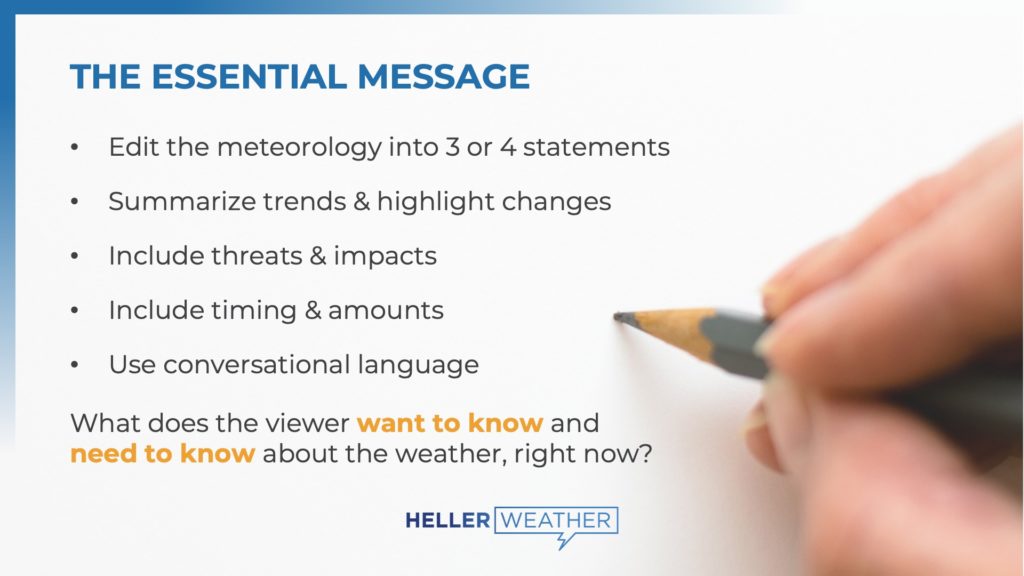Be the Go-To Weather Expert in Your Community

Every TV station wants to be the go-to source for the latest news, weather, and sports in their community. Likewise, every broadcast meteorologist wants to be the go-to source for the most accurate forecast. But it isn’t easy when the go-to news and weather source for many people is the smartphone.
TV news ratings, website page views, and social media rankings tell us how successful we are at being the go-to. We spend a lot of time, energy, and money monitoring those numbers and trying to make them climb a little higher each day.
 When it comes to weather, some TV stations will spend a million dollars on a million-watt radar. Some purchase storm-chasing vehicles or buy into a network of tower cameras and weather stations installed at schools. There’s definitely promotional value in these investments, and occasionally the weather team will capture some interesting data using these tools. But from the viewers’ point of view, the data from that million-dollar radar looks like NEXRAD, and the temperature from the local elementary school looks like the temperature at the airport.
When it comes to weather, some TV stations will spend a million dollars on a million-watt radar. Some purchase storm-chasing vehicles or buy into a network of tower cameras and weather stations installed at schools. There’s definitely promotional value in these investments, and occasionally the weather team will capture some interesting data using these tools. But from the viewers’ point of view, the data from that million-dollar radar looks like NEXRAD, and the temperature from the local elementary school looks like the temperature at the airport.
Piling more data into the weathercast doesn’t set you apart. Stand out by focusing on the one thing that is different between you and the competition: you!
The information you share with viewers and how you communicate that information can distinguish you in the market and establish you as the go-to person for weather information in your community.
DON’T TELL A WEATHER STORY. DO THIS INSTEAD.
Consultants tell us that a good weathercast tells a good story. That’s not necessarily bad advice, but it doesn’t provide any guidance on how to structure the weathercast.
For broadcast meteorologists, data is the story. Just like doctors see a story when they look at x-rays, and accountants see a story when they study a spreadsheet, meteorologists see a story in surface observations, upper air charts, satellite, radar, and forecast models. That’s why most weathercasts are filled with data!
These types of stories don’t make sense to most people. Consumers need help interpreting them. Here’s a better suggestion: deliver the message.
After completing the forecast, and before you start working on the graphics, stacking weather hits, updating the website and sharing content on social media, take a moment and figure out the message you want to communicate to your viewers and followers. Edit the meteorology into 3 or 4 clear, concise statements that highlight trends and summarize changes in the weather. Include threats and impacts, timing and amounts. Use conversational language, not meteorological terminology. Focus on the essential information consumers want and need to know about the weather right now.

Ideally, this “Essential Message” should be written down. This helps articulate the specific message you want to deliver. It keeps the weather coverage consistent throughout the day and among the entire weather team. Be aware it might need to be updated if the weather changes between newscasts or perhaps during the newscast.
DARE TO BE DIFFERENT
After determining the Essential Message, take another moment to consider the specific graphics and scenes you can use to deliver the message. Can you creatively combine complex data to explain part of the message? Is there a way to present the information using dynamic augmented reality scenes? What can you produce that’s different from the competition and more engaging than what consumers will see on their smartphone?
READ MORE: METEOROLOGY MARKETING BUILDS WEATHER AWARENESS AND BRAND LOYALTY
Include small, teachable moments in your weathercasts to demonstrate your expertise. Share your personality. Intentionally try and connect with your viewers on an intellectual, emotional, and visceral lever. That’s how you differentiate your weather coverage from the weather app, as well as the other broadcast meteorologists in your market.
FEWER NUMBERS, MORE WORDS
When you think about it, the forecast is a numbers game. Temperatures, humidity, dew point, wind speed are all numbers. Even the words “partly” and “mostly” relate to a percentage and infer a numerical quantity in the viewer’s mind.
Those numbers are important! However, consumers can get the numbers anywhere. The smartphone forecast shows a lot of numbers, and it’s easier to access than your weathercasts. You won’t win if all you offer your viewers and followers is more data, more numbers. You won’t stand out. You won’t build a following.
 Go beyond the numbers and concentrate on The Essential Message you want to deliver. The few minutes of extra prep time at the beginning of the workday saves time later when you’re producing your weather hits. You’ll know exactly what to include and what to leave out. It keeps you on-message and prevents you from over-producing. More importantly, you’ll distinguish yourself from the other broadcast meteorologists in the market and separate your weather coverage from the smartphone.
Go beyond the numbers and concentrate on The Essential Message you want to deliver. The few minutes of extra prep time at the beginning of the workday saves time later when you’re producing your weather hits. You’ll know exactly what to include and what to leave out. It keeps you on-message and prevents you from over-producing. More importantly, you’ll distinguish yourself from the other broadcast meteorologists in the market and separate your weather coverage from the smartphone.
Broadcast meteorologists spend a lot of time working on the forecast and creating new graphics. Spending time working on the one thing that differentiates you from the competition is a worthy habit. Position yourself as the one person in your community who understands what people want and need to know about the weather. Effectively deliver the Essential Message every day, on every platform.
Tim Heller is an AMS Certified Broadcast Meteorologist, Talent Coach, and Weather Content Consultant. He helps local TV stations and broadcast meteorologists communicate more effectively on-air, online, and on social media.
Read more News & Insights from HellerWeather
